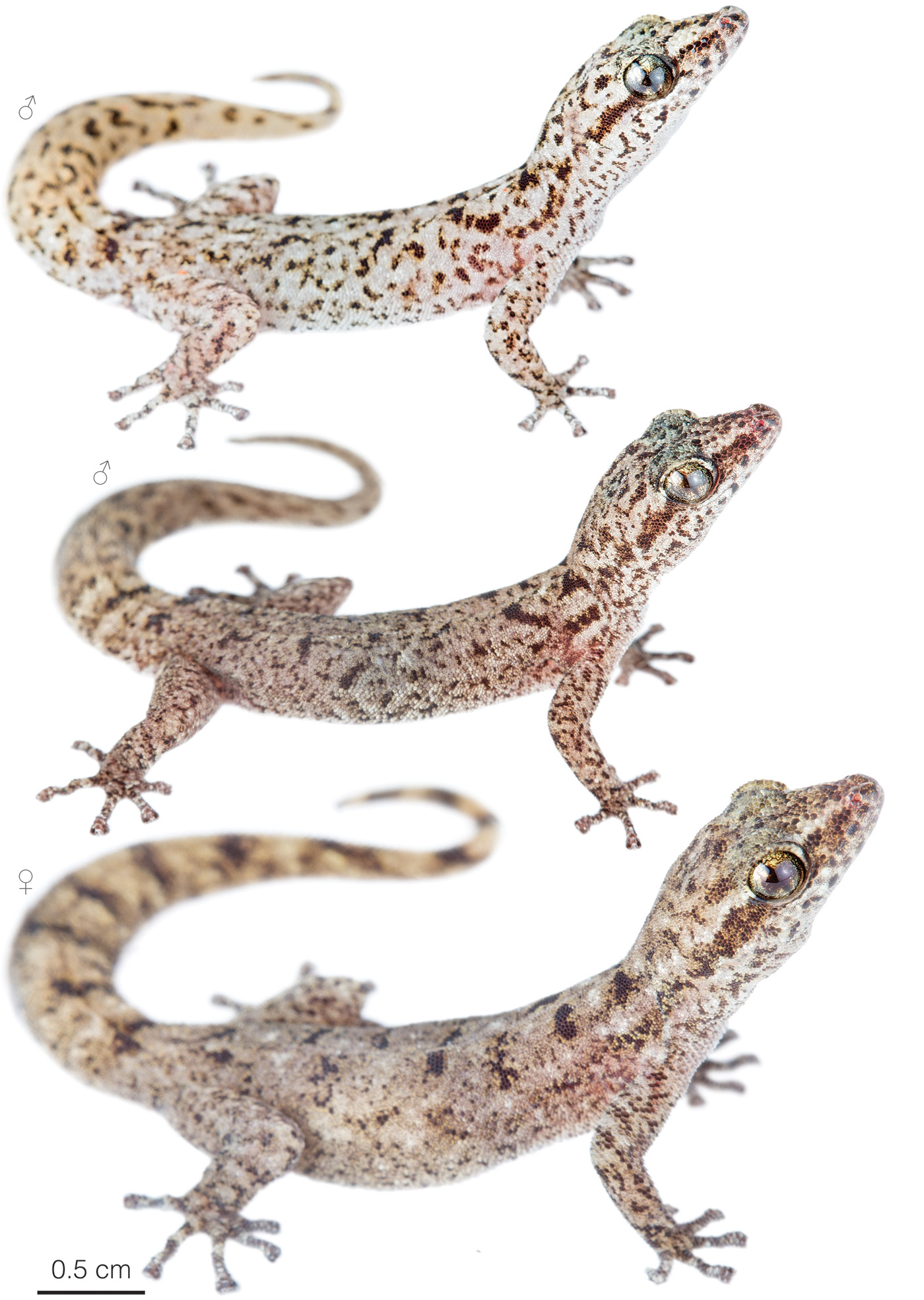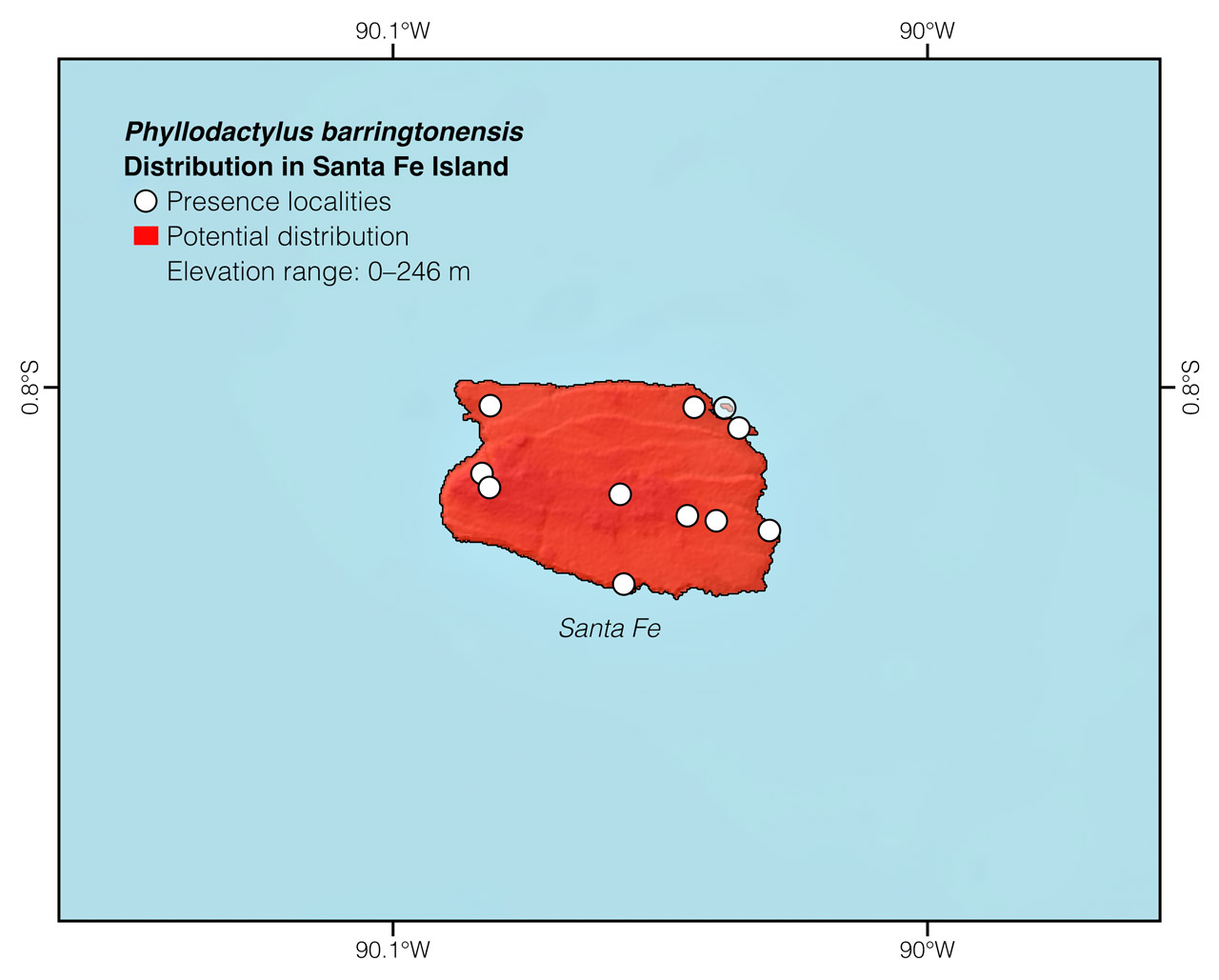Published October 10, 2019. Updated December 21, 2023. Open access. Peer-reviewed. | Purchase book ❯ |
Santa Fe Leaf-toed Gecko (Phyllodactylus barringtonensis)
Reptiles of Ecuador | Sauria | Phyllodactylidae | Phyllodactylus barringtonensis
English common name: Santa Fe Leaf-toed Gecko.
Spanish common name: Geco de Santa Fe.
Recognition: ♂♂ 7.3 cmMaximum distance from the snout to the tip of the tail. ♀♀ 8.7 cmMaximum distance from the snout to the tip of the tail..1 Phyllodactylus barringtonensis is easily distinguishable from other lizards occurring on Santa Fe Island (that is, iguanas and lava lizards) by its nocturnal habits, vertical pupils, and fingertips lacking visible claws.1 No other gecko has been recorded on Santa Fe. The dorsal coloration is usually pale grayish brown with faint irregular dark blotches and scattered spots (Fig. 1).1

Figure 1: Individuals of Phyllodactylus barringtonensis from El Miedo, Santa Fe Island, Galápagos, Ecuador.
Natural history: Phyllodactylus barringtonensis is a nocturnal and mostly terrestrial gecko that occurs in comparatively high densities in the seasonally dry forests of Santa Fe Island. This species forages on soil, rocky outcrops, and cacti in areas of dry shrubland. Santa Fe Leaf-toed Geckos are nocturnal and most active just after sunset until 7:30 pm.1 During daytime, they seek refuge under lava blocks and cactus stumps.2 When threatened, these shy geckos flee into crevices. If captured, they may shed the tail. There are recorded instances of predation on members of this species, including by lizards (Microlophus barringtonensis) and snakes (Pseudalsophis dorsalis).1
Conservation: Least Concern Believed to be safe from extinction given current circumstances..3 Phyllodactylus barringtonensis is listed in this category because the species is not undergoing population declines nor facing major immediate threats of extinction. Santa Fe Island is free of exotic predators, not populated by humans, and protected within the Galápagos National Park. However, since the entire gecko population is restricted to a small island, the species is prone to be affected by random, unpredictable events (like droughts and introduced species) within a short time period.1
Distribution: Phyllodactylus barringtonensis is endemic to Santa Fe Island in Galápagos (Fig. 2), Ecuador. Santa Fe is a small and relatively flat island with an area of 24 km2 and a maximum elevation of 250 m above sea level (Fig. 3). The vegetation of the island is dominated by the palo santo tree (Bursera graveolens) and the giant prickly pear cactus (Opuntia echios).

Figure 2: Distribution of Phyllodactylus barringtonensis in Galápagos. See Appendix 1 for a complete list of the presence localities included in the map.

Figure 3: Distribution of Phyllodactylus barringtonensis in Santa Fe Island. See Appendix 1 for a complete list of the presence localities included in the map.
Etymology: The generic name Phyllodactylus comes from the Greek words phyllon (=leaf) and daktylos (=finger),4 and refers to the leaf-shaped fingers characteristic of this group of geckos. The specific epithet barringtonensis refers to Santa Fe, previously known as Barrington Island.1
See it in the wild: Since the species is nocturnal, individuals of Phyllodactylus barringtonensis are unlikely to be seen during touristic day trips to Santa Fe Island. Researchers and members of the Galápagos National Park may visit Santa Fe Island at night, but only in the context of a scientific expedition or a conservation agenda.
Special thanks to Ellen Smith for symbolically adopting the Santa Fe Leaf-toed Gecko and helping bring the Reptiles of Ecuador book project to life.
Click here to adopt a species.
Authors: Alejandro Arteaga,aAffiliation: Fundación Khamai, Reserva Arlequín, Ecoruta Paseo del Quinde km 56, Santa Rosa de Mindo, Pichincha 171202, Ecuador. Gabriela Aguiar,bIndependent researcher, Quito, Ecuador. and Juan M GuayasamincAffiliation: Universidad San Francisco de Quito, Quito, Ecuador.
Academic reviewer: Cruz MárquezdAffiliation: University of Rome Tor Vergata, Rome, Italy.
Photographer: Alejandro ArteagaaAffiliation: Fundación Khamai, Reserva Arlequín, Ecoruta Paseo del Quinde km 56, Santa Rosa de Mindo, Pichincha 171202, Ecuador.
How to cite? Arteaga A, Aguiar G, Guayasamin JM (2023) Santa Fe Leaf-toed Gecko (Phyllodactylus barringtonensis). In: Arteaga A, Bustamante L, Vieira J (Eds) Reptiles of Ecuador: Life in the middle of the world. Available from: www.reptilesofecuador.com. DOI: 10.47051/PRHV9309
Literature cited:
- Arteaga A, Bustamante L, Vieira J, Tapia W, Guayasamin JM (2019) Reptiles of the Galápagos: life on the Enchanted Islands. Tropical Herping, Quito, 208 pp. DOI: 10.47051/AQJU7348
- Van Denburgh J (1912) Expedition of the California Academy of Sciences to the Galápagos Islands, 1905-1906. VI. The geckos of the Galápagos Archipelago. Proceedings of the California Academy of Sciences 1: 405–430.
- Márquez C, Yánez-Muñoz M (2022) Phyllodactylus barringtonensis. The IUCN Red List of threatened species. Available from: www.iucnredlist.org. DOI: 10.2305/IUCN.UK.2022-1.RLTS.T48443458A217808382.en
- Brown RW (1956) Composition of scientific words. Smithsonian Books, Washington, 882 pp.
Appendix 1: Locality data used to create the distribution map of Phyllodactylus barringtonensis in Ecuador (Fig. 2). Go to the section on symbols and abbreviations for a list of acronyms used.
| Country | Province | Locality | Source |
| Ecuador | Galápagos | Barrington Bay | Arteaga et al. 2019 |
| Ecuador | Galápagos | Barrington Islet | Lanza 1973 |
| Ecuador | Galápagos | El Miedo | Arteaga et al. 2019 |
| Ecuador | Galápagos | Encañada 2 | Arteaga et al. 2019 |
| Ecuador | Galápagos | Interior, 106 m | Arteaga et al. 2019 |
| Ecuador | Galápagos | Santa Fe, meseta | Arteaga et al. 2019 |
| Ecuador | Galápagos | Santa Fe, northeast corner | Arteaga et al. 2019 |
| Ecuador | Galápagos | Santa Fe, northwest corner | Arteaga et al. 2019 |
| Ecuador | Galápagos | Santa Fe, southern shore | Arteaga et al. 2019 |
| Ecuador | Galápagos | Santa Fe, western shore | Arteaga et al. 2019 |
| Ecuador | Galápagos | Top of hill | Arteaga et al. 2019 |